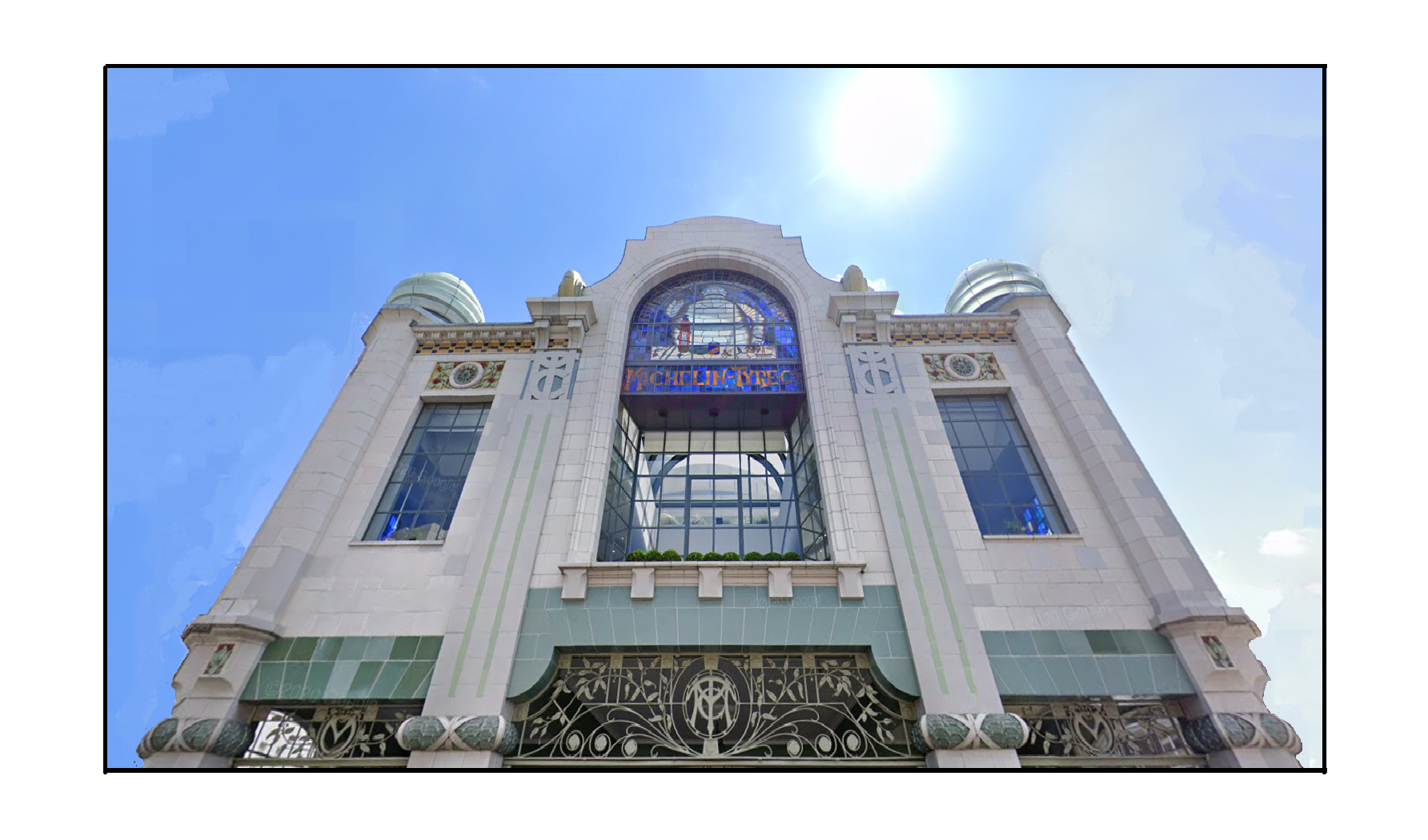
The Hammersmith flyover, concrete front gardens and the sacrifice of thousands of buildings on the altar of road improvements: The metropolis shows many scars from the 20th century’s obsession with the internal combustion engine. But what petrol-related contributions to London’s skyline can we look upon more favourably? The next time you find yourself at a faded Kwik Fit or dreary car dealership, close your eyes and dream you are in one of the following.
![]() Royal Automobile Club, 1911
Royal Automobile Club, 1911
The most spectacular of the structures I’ve selected, and the earliest to be started – in 1908 – this vast edifice on Pall Mall is described in the London Encyclopaedia as the ‘least intimate’ of the old-fashioned St James’s gentlemen’s clubs. Given its scale, this is hardly a surprise. The architects, Mewes and Davis, were also responsible for the Ritz Hotel nearby and the two are constructed in a similar fashion – a steel and concrete structure clad in Portland stone. The design of the facade was inspired by the buildings on the Place de la Concorde in Paris. One of those, coincidentally, now houses the FIA – the governing body of motorsport.
The Royal Automobile Club was established as far back as 1897, for ‘the protection, encouragement and development of automobilism’, which serves to prove only that the English language was not coping well with this new-fangled invention. It acquired the ‘Royal’ moniker at the command of car enthusiast King Edward VII in 1907, and spies Guy Burgess and Donald Maclean supposedly had a spot of lunch here shortly before fleeing to Russia in 1951.
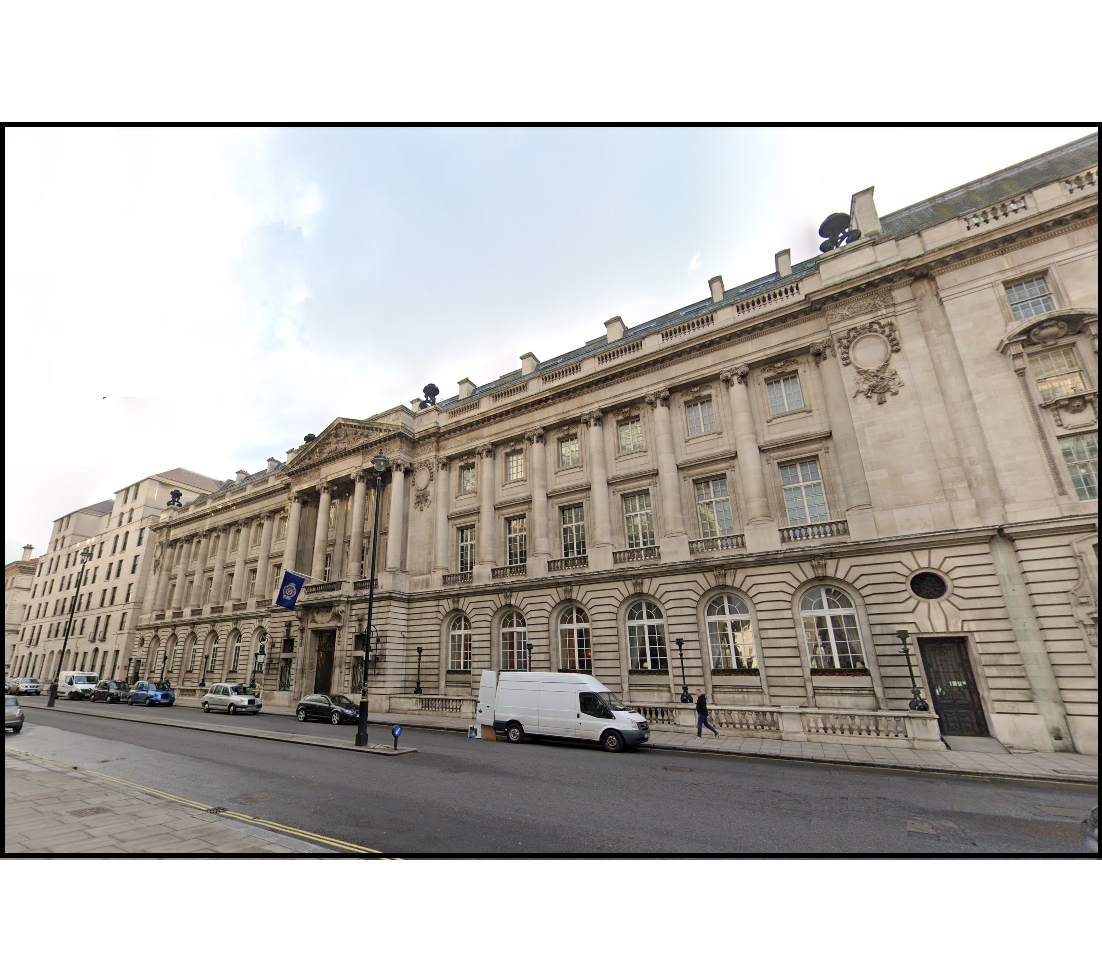
→The RAC has ample space for its current 13,500 members, although how many of those are car enthusiasts is unclear. Many join to use the swimming pool.
It is listed Grade II*, while the 1915 extension – to the right, just out of shot – is a more modest Grade II.
As with the facade, the interior is on a grand scale. There are vast public rooms in a Grand Siècle style. There is also a spectacular basement ‘Pompeian’ swimming pool with scale-patterned mosaic columns, along with a Turkish bath, large billiards room and a post office. This is a palace built on a passion for cars, but seemingly containing little that is car-related. It doesn’t even have a car park.
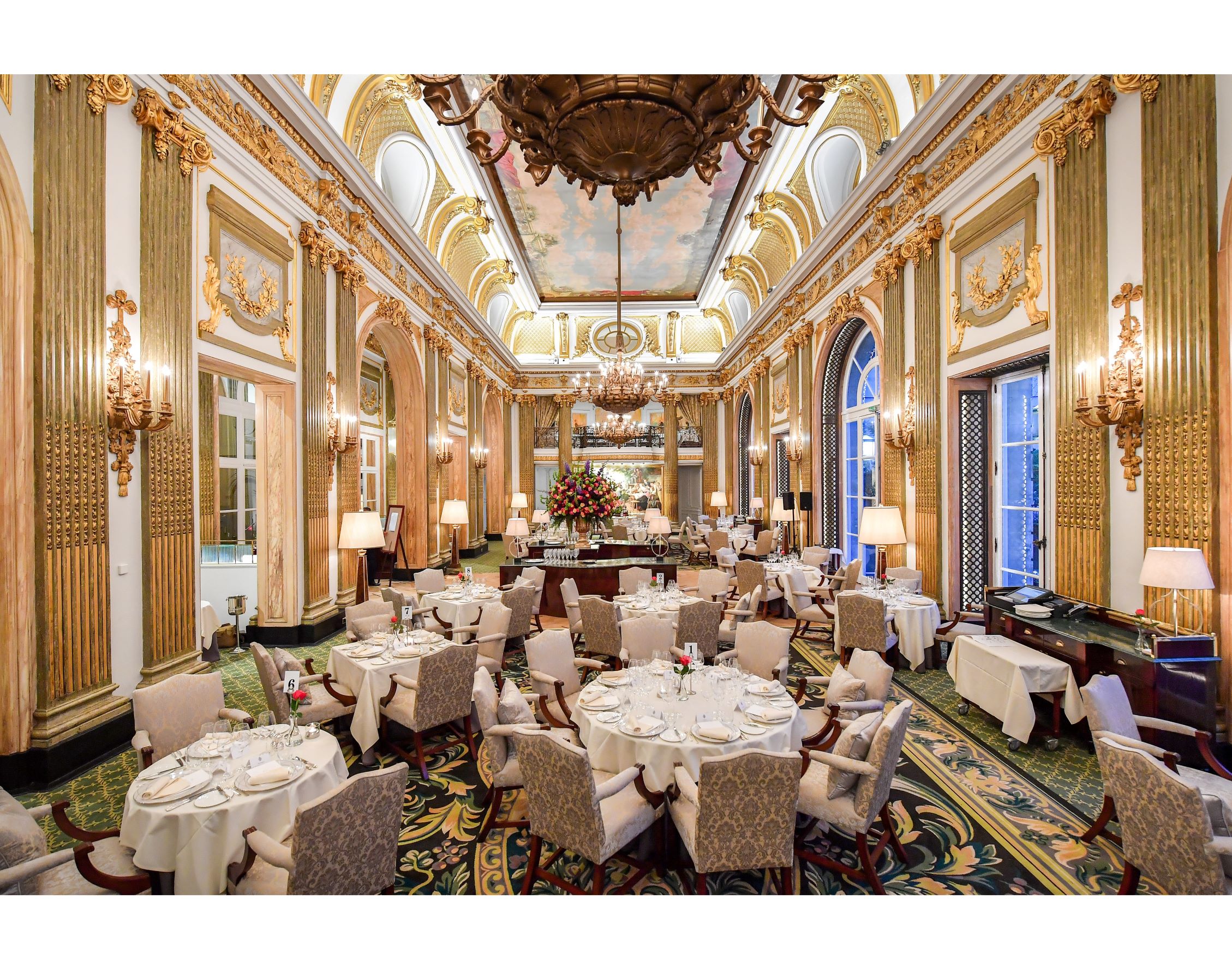
← The Great Gallery, which can best be described as Grand Siècle with knobs on. Just the place to discuss crankshafts and cambelts, but oily overalls are probably not encouraged.
The club’s main connection with the motor car, the roadside assistance company RAC Limited, was originally its ‘associate section’. It was hived off as a separate subsidiary in 1978 and sold off in 1999 for £437m, resulting in each member of the club getting a £34,000 windfall. Nice.
The Royal Automobile Club building was designed to make a statement while blending in with its surroundings. The next structure, completed in the same year, opted for a look that was the architectural equivalent of a bird of paradise perched among sparrows.
![]() The Michelin Building, 1911
The Michelin Building, 1911
This was the first permanent UK headquarters and tyre depot for the Michelin Tyre Company, and opened in 1911 after just three months’ construction. The architect was the little-known Michelin employee François Espinasse (1880–1925). It is another early example of concrete construction, and designed in what might be described as freestyle Art Nouveau. It is absolutely stunning.
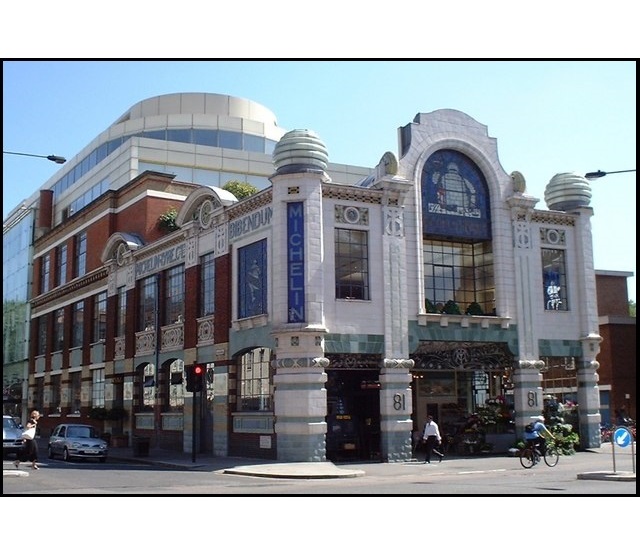
←The extraordinary Michelin House, 81 Fulham Road, West London, with later additions of various vintages behind.
It has three stained-glass windows based on the company’s advertising of the time, featuring the Michelin Man who, apparently, is called ‘Bibendum’. The ground floor exterior features decorative tiles showing famous racing cars that used Michelin tyres. There are more tiles inside the front hall, including a depiction of Edward VII and the Prince of Wales in their Michelin-fitted car. The building had tyre-fitting bays for passing motorists; tyres were brought up on a lift from a vast basement that could hold 30,000, and rolled to the front down a sloped floor.
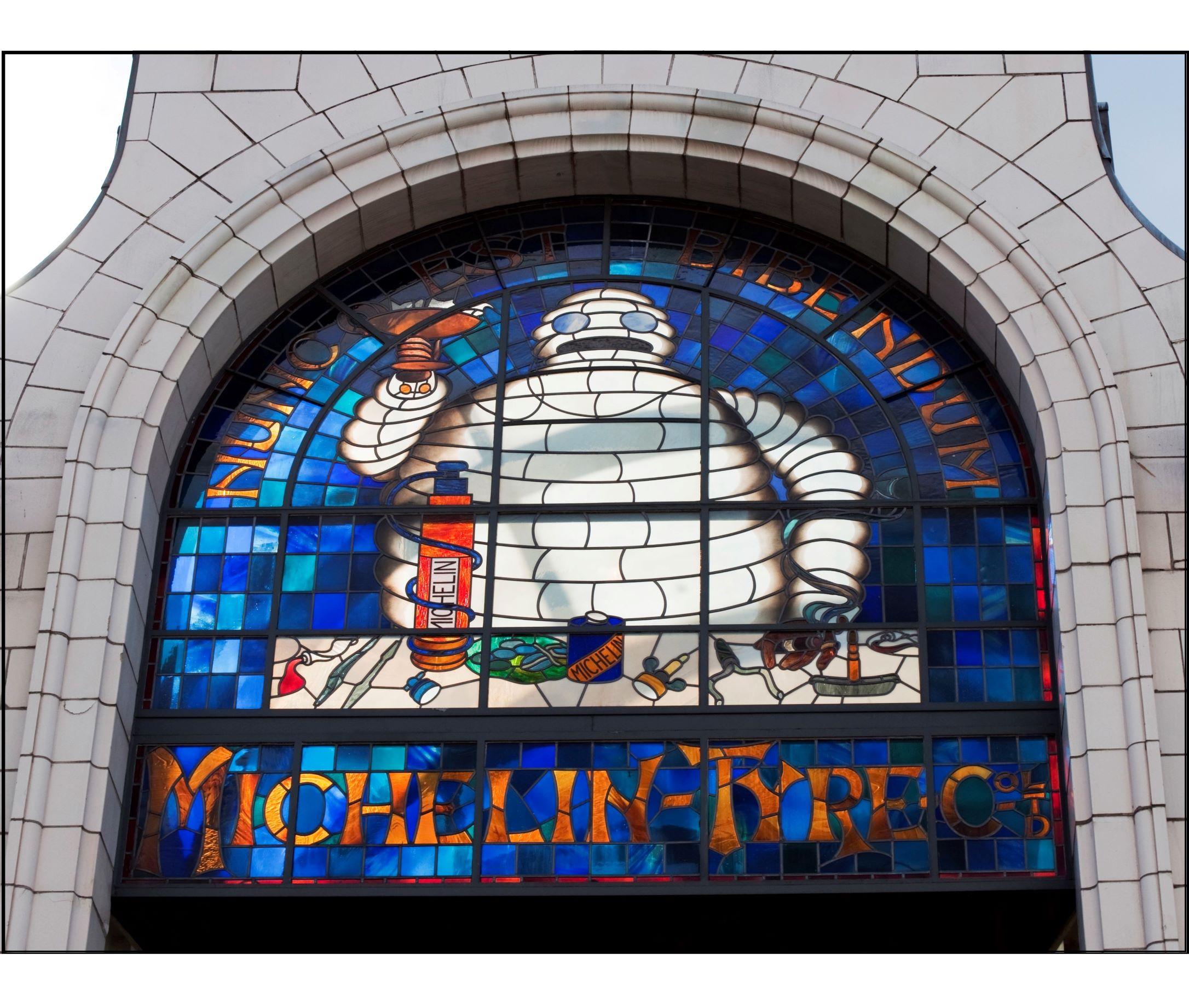
→ The central window, which replicates a floor mosaic surviving in the former tyre workshop at the front of the building. Bibendum holds up a goblet containing nuts and bolts, and declares ‘Nunc Est Bibendum’ – ‘Now is the time to drink’
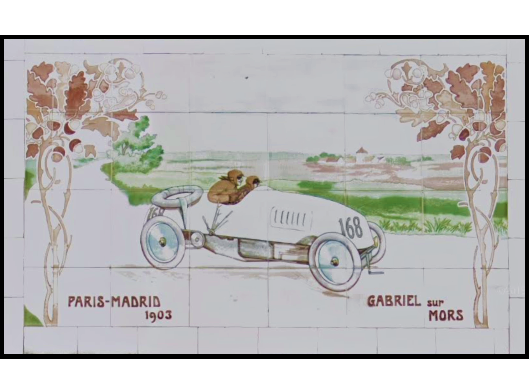
← One of the tile illustrations is of Fernand Gabriel (1880-1943) in a Mors car competing in the 1903 Paris-Madrid race. This ended at Bordeaux after the deaths of several drivers, including Marcel Renault, co-founder of the eponymous company. Gabriel was declared the winner.
Changes and extensions began almost immediately after completion and continued on into the 1960s. In 1969 the original front section was listed Grade II; Michelin’s use of the building began to decline and the company moved out altogether in 1985. In August of that year it was sold to a consortium led by Sir Terence Conran. The renovation that followed created additional floor space and removed unsympathetic 1960s interior additions. The stained-glass windows are recreations – the originals were lost after being put into storage during the Second World War. The cupolas that look worryingly like the dismembered torso of the Michelin Man are also replicas. It is now office and retail space, with a bar-restaurant on the ground floor called, unsurprisingly, Bibendum. Cheers.
![]() Citroën House, 1916
Citroën House, 1916
Standing on the Shepherd’s Bush Road, and originally built for Ford, this is another building making early use of reinforced concrete. It was designed by Heathcote & Sons, who were also responsible for Ford’s Dagenham factory. The building was bought by Citroën in 1923, requisitioned by the RAF in the Second World War and later used by Osram, the light-bulb maker.
Showrooms took up most of the ground floor, with offices and servicing areas above, and a test ‘track’ for new cars on the roof. Large lifts at each end of the building could move vehicles between floors. It should, supposedly, have had a fourth floor but wartime restrictions on building supplies made this impossible.
The building was redeveloped into offices in 2016. The facade and some internal aspects of the building have been preserved, including the former ground floor showroom with mahogany paneling and tiled floor; a white marble staircase with a mahogany handrail, and first floor toilets with solid white marble slab cubicle partitions and original handbasins. A ‘diagrid’ glass structure adding three floors of additional office space has been built on the former roof test track. The large lifts at either end of the building – working until 2016 – have gone, as has its near 100-year old name. The building is now known simply as 184 Shepherd’s Bush Road.
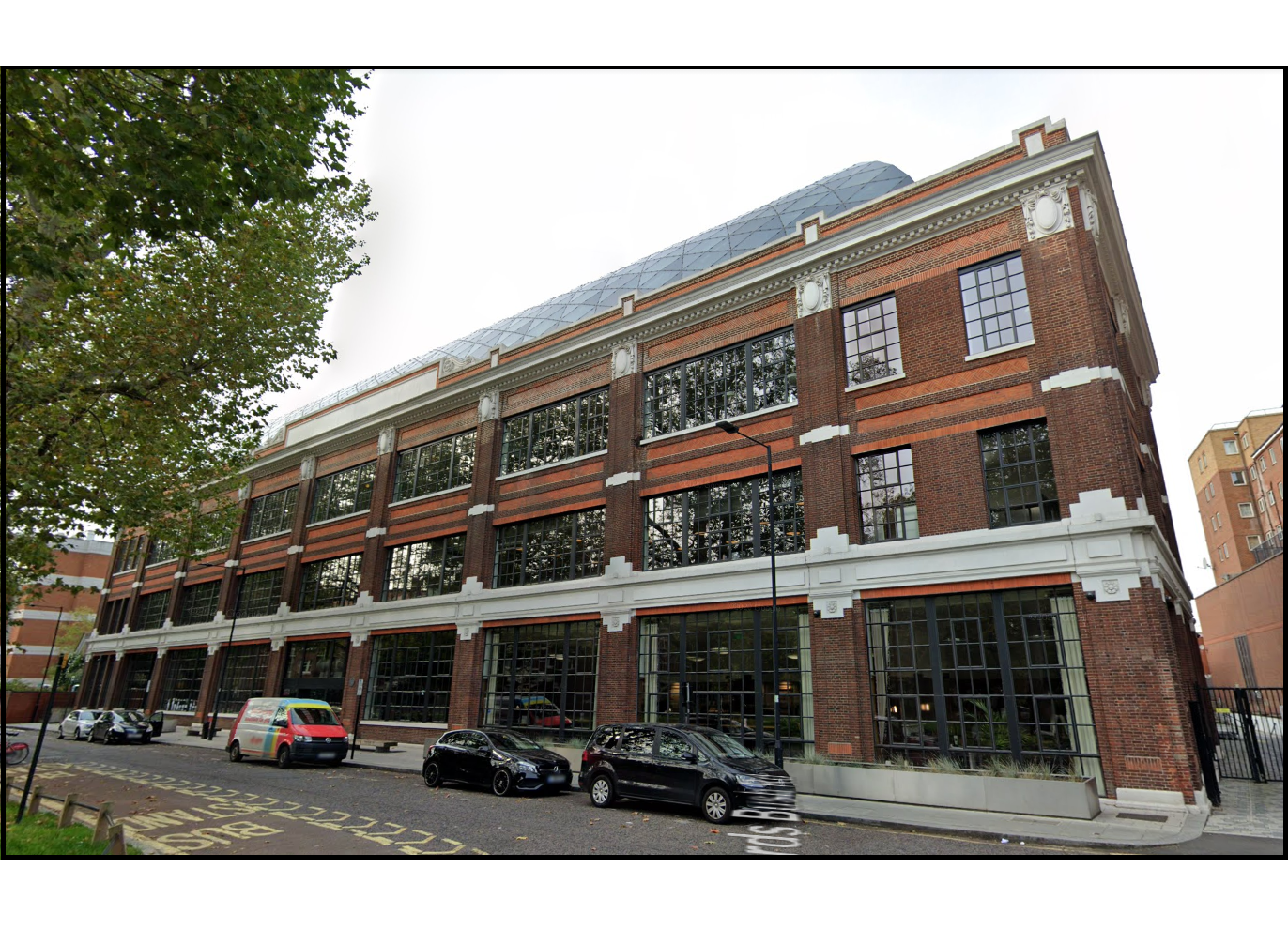
→ The 1916 brick and concrete detailing is certainly stylish. The glass roof extension was presumably seen as the best way of adding new floors without compromising the original design.
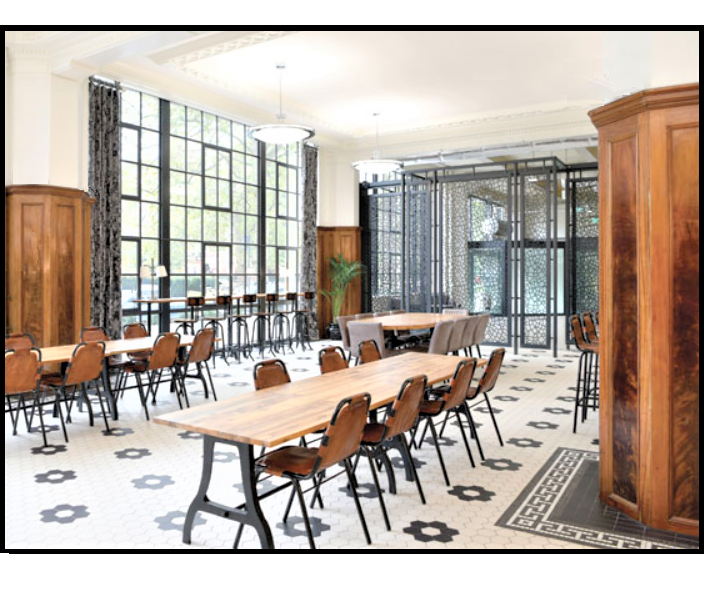
← Surviving mahogany panelling is attached to octagon supporting columns that rise from monochrome patterned tiling in the former showroom area.
‘The quality of materials and design reflect the status of the motor car at this period’ says Historic England in its Grade II listing. Or, to misquote L.P. Hartley, ‘The past is a foreign country – they buy cars differently there’. And as if to prove the point, welcome to …
![]() Wolseley Car Showroom, 1921
Wolseley Car Showroom, 1921
This Piccadilly edifice, faced in Portland stone both inside and out, has five floors of offices above a deluxe ground floor car showroom with intricate monochrome floor designs, black, gold and red lacquer detailing and columns holding up elegant arched ceilings. It was designed by William Curtis Green. Wolesley occupied the entire building, and these six floors of imperial classicism represented £250,000-worth of spectacular overconfidence. Wolesley went bust in October 1926 and was bought at auction by William Morris, Viscount Nuffield, in February the following year. The showroom and offices closed immediately.
The building became a branch of Barclays Bank, with necessary minor alterations made by Curtis Green, and Barclays remained the occupant until 1999. It has been occupied by The Wolesley, a self-styled ‘Grand Café’, since 2003. It is listed Grade II*, although intriguingly the Historic England entry describes the interior as that of a banking hall rather than a car showroom.
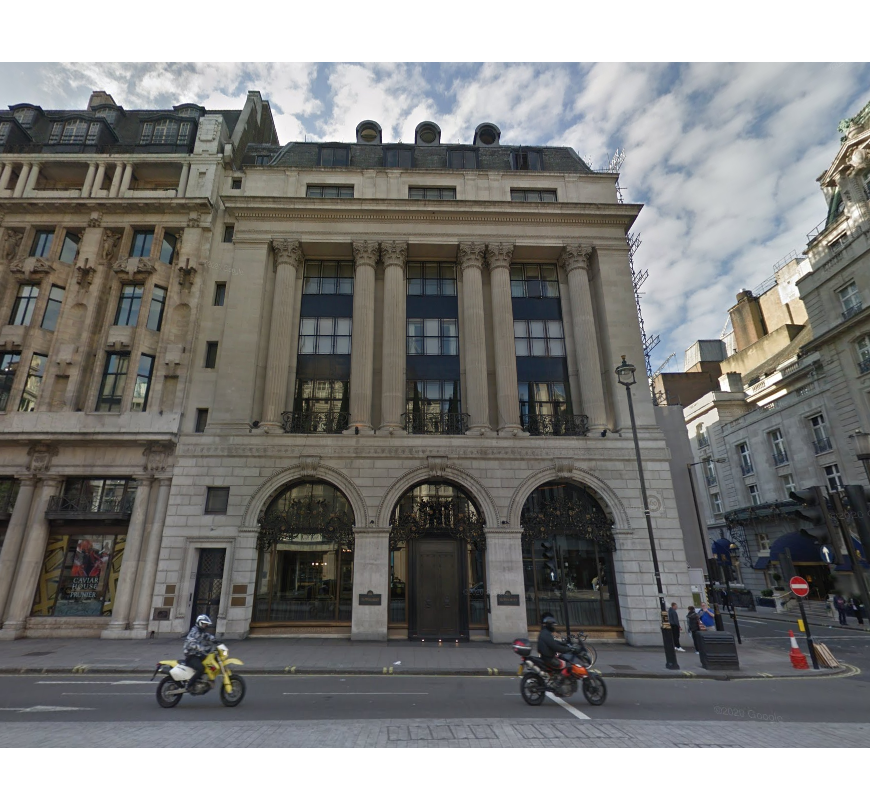
← Even more unlike today’s car emporia than Citroën House: The Wolseley, Piccadilly, in 2020.
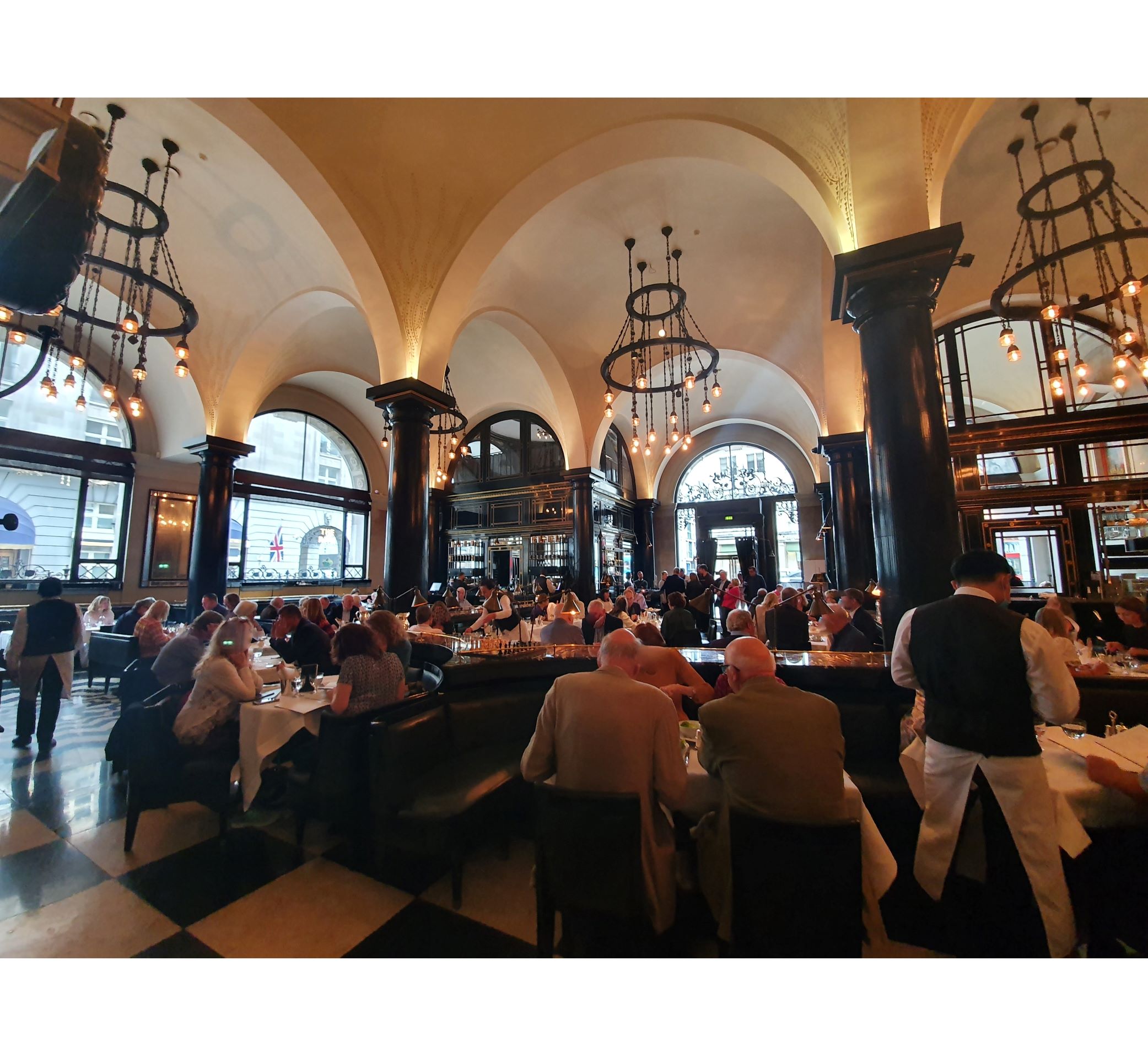
→ The main showroom area, now the main dining room. Many of the 1921 features survive, including the floor tiles and ceiling lights.
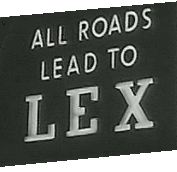 Lex Garage, 1929
Lex Garage, 1929
The impressive former Lex Garage in Brewer Street, Soho (a side wall faces Lexington Street) is defaced by unsympathetic modern NCP signage. Despite this, its four storey faience frontage facing Brewer Street has considerable impact in a Soho area dominated by Victorian and Edwardian red brick low rise buildings. It is also one of the earliest surviving multi-storey car parks in Britain.
It occupies the site of the 18th century William and Mary Yard. A decorative tower has a copper-clad dome and originally housed bathrooms on all levels. These have been lost, along with turntables at the centre of each floor, the chauffeurs’ canteen, owners’ café, and the garage and petrol pumps on the ground floor and forecourt. When it opened, it could accommodate 1,000 cars over five floors including the basement. Built primarily to serve those people coming into theatreland by car, it was described at its opening as ‘probably the largest and best-equipped building for the service of the motor-car that has yet appeared in this congested city’.
It will come as no surprise that plans to build a golf course on the roof didn’t materialise, and now it’s just another car park – albeit very centrally placed and with a Grade II listed frontage. This protection saved it from demolition and an £80m redevelopment in 2002, although it can’t be long before a scheme that maximises the potential of this large parcel of land while retaining the Brewer Street facade gets the green light.
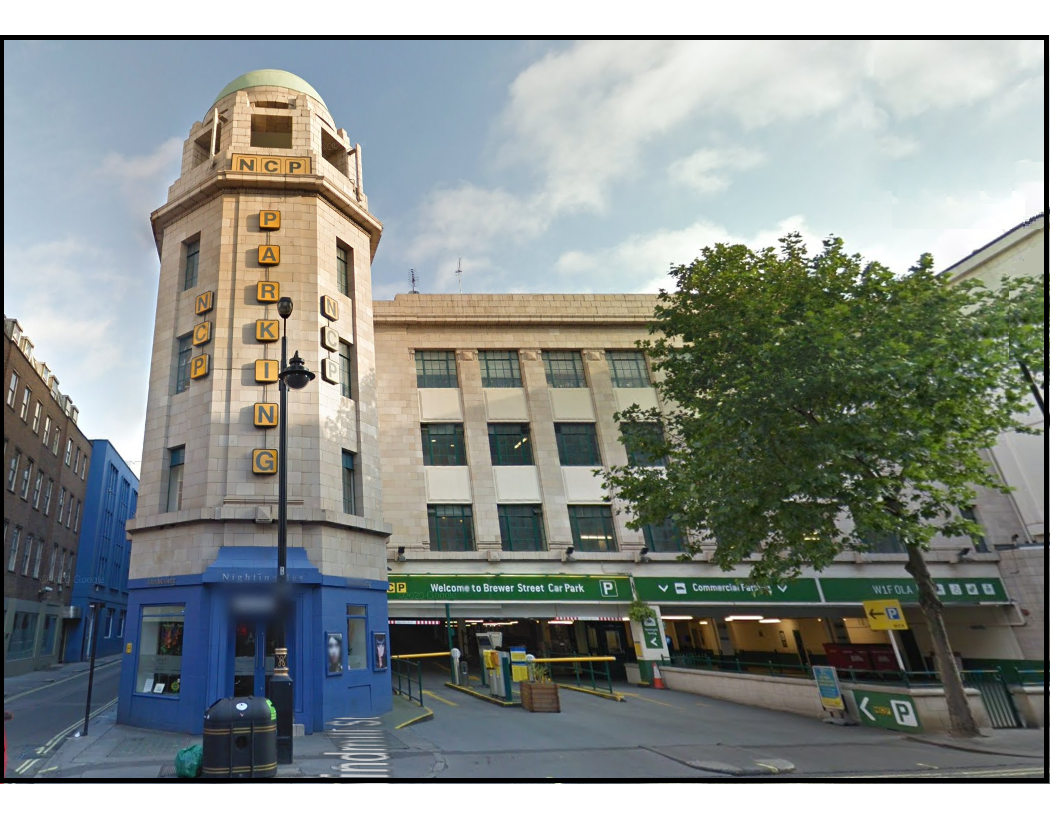
← Historic England describes the elevation to Brewer Street as ‘Classical-Moderne’. I call it ‘difficult to photograph with that tree in the way’.
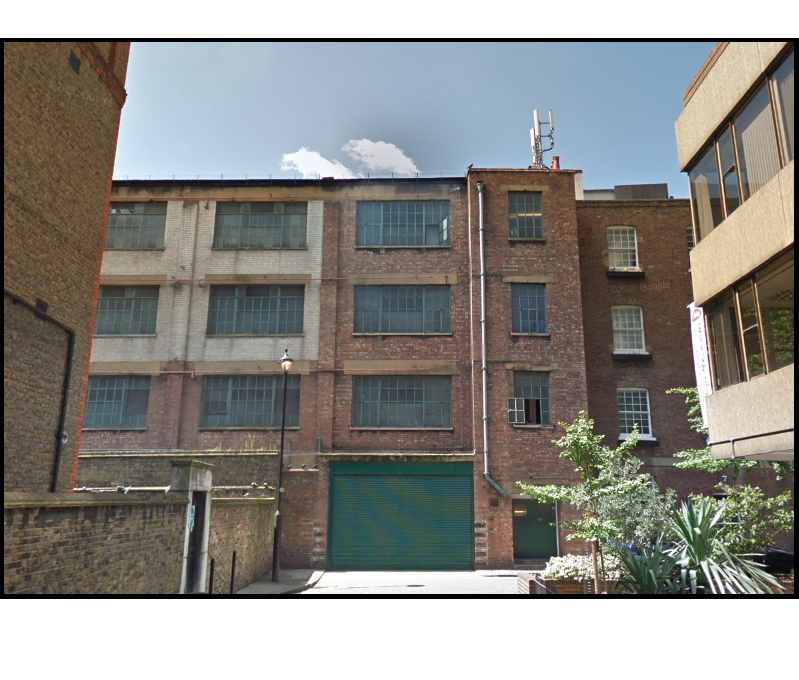
←The long, narrow site dictated by the layout of William and Mary Yard at least allowed an exit onto Ingestre Place, a narrow dog-leg back street. No need to spend money on a faience finish here – cheap London brick will do.
![]() Car Hire & Frames Coach Station, 1931
Car Hire & Frames Coach Station, 1931
This extraordinary art deco ‘modernistic’ survivor in Herbrand Street, Bloomsbury, was built for Daimler Car Hire Ltd in reinforced concrete, and is now listed Grade II. It combined offices with a 4-storey garage. Daimler-owned cars for hire were stored on the upper floors while the basement was used as a public car park, with a waiting-room, attendant’s office, lavatories and telephones. Each floor had an electrically operated pressure washer to clean the cars. There was also an integrated single storey coach station to the rear for Frames Ltd.

← The detailing on the original offices on the left, accessed by the small semi-circular stair turret in the centre of the image, rewards a closer look. The entrance to the former basement public car park is below the offices.
The projecting lift shaft has a narrow vertically set window emphasised by vertical strips of coloured faience, a moulded concrete balcony at the base, and three corner windows at each floor level on the left hand angle which light the adjoining stairwell. To the right of the lift shaft, the spiral car ramp giving access to upper floors has always been glazed – a nice touch.
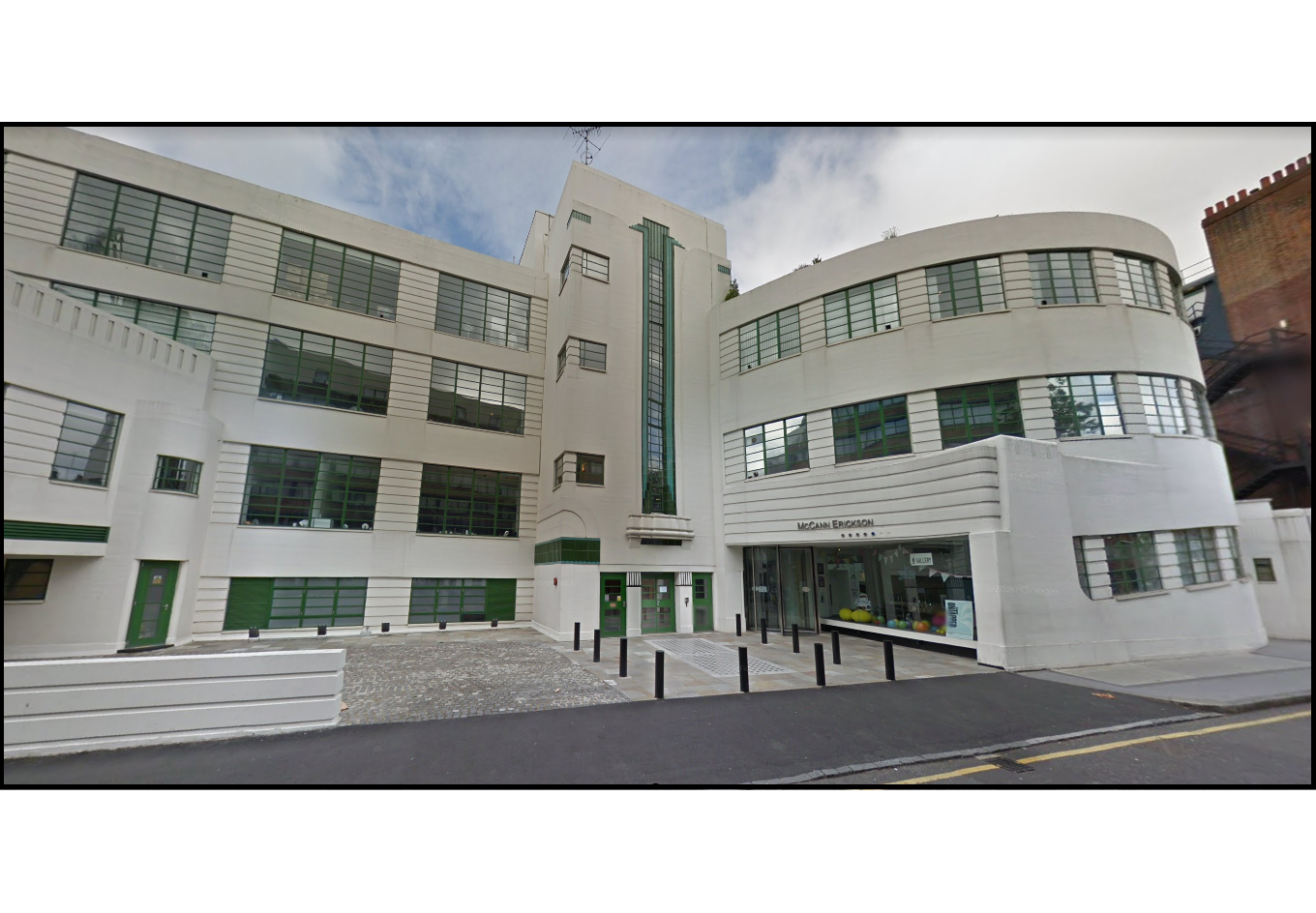
→The lift shaft and stairwell, with the spiral ramp and upper floors now converted to offices.
The coach station is long gone, but there are still a few of the original parking spaces in the basement available for use by the building’s office workers.
The Talisman Building, 1939
Best described as a sleeker version of the Daimler building, and originally built as the J.C. Brodie petrol and service station, the Talisman building sits on the exclusive New King’s Road, west London. It narrowly escaped demolition in the early 2000s and still isn’t listed. Until recently the ground floor was occupied by Talisman Antiques – it will soon be a Piano showroom – and there are some very expensive apartments on the upper floors commanding views of Eel Brook Common opposite. What makes this worth mentioning is the simple lines of the building itself paired with a series of attractive – though I believe not contemporary – lamps on the forecourt.
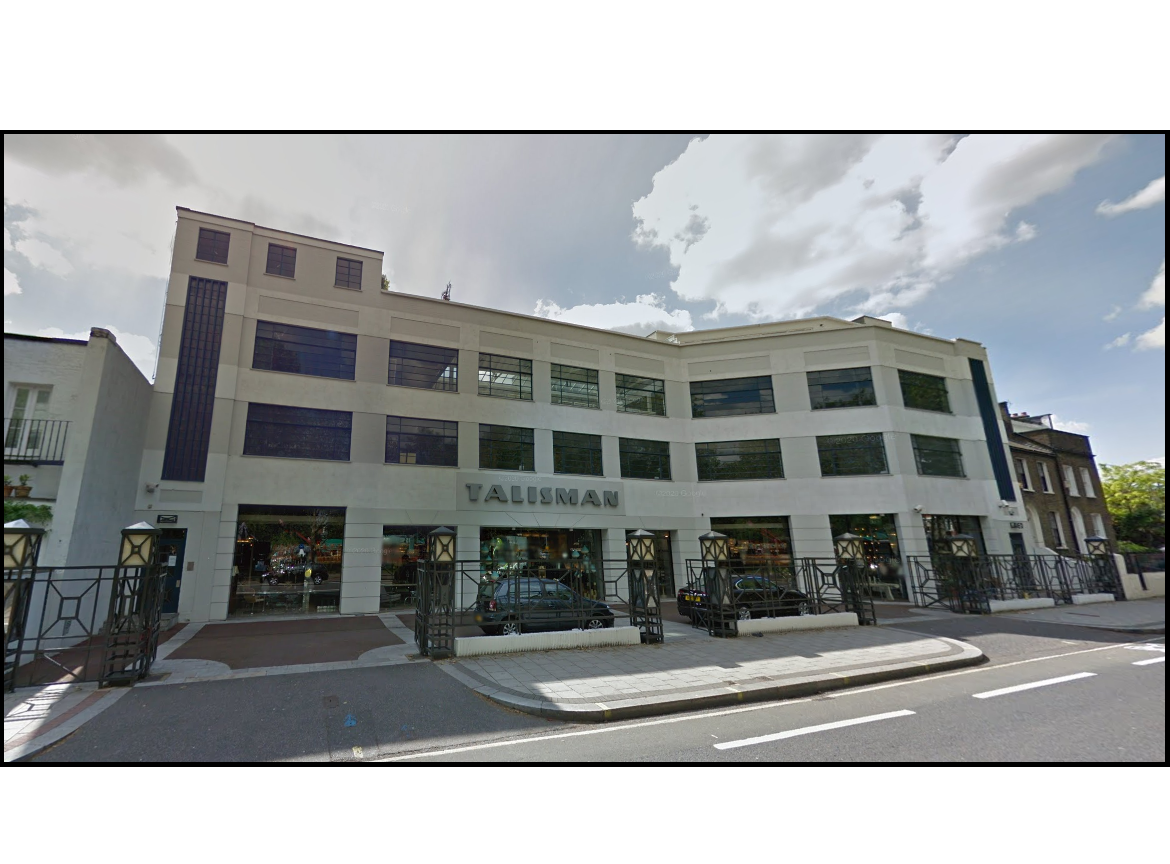
← The eight years separating the Daimler and Talisman buildings explain the more reticent decoration here.
Little of the original interior has survived but as with the Daimler building, its appearance among much older structures must come as a shock to the passer-by.
Ace Cafe, 1949
Not the greatest of buildings architecturally – far from it – but included here as one held in deep affection by bikers and even a few classic car owners. Besides, how many buildings possess a blue plaque to Screaming Lord Sutch, founder of the Monster Raving Loony Party?
It opened as a transport cafe – and very typical of its breed – in 1938 on the North Circular Road near Wembley, but was partially demolished by high explosive bombs in late 1940. It was not until 1949 that a permanent replacement, much larger than the first building, was completed. It quickly became a magnet for rockers and other bikers – mods unwelcome – but closed in 1969 after facing increasing competition from nearby motorway services. It eventually becoming a tyre centre, with the big picture windows converted into doors for the cars. However, the legend was alive and well and after a few events on the site proved there was a demand, it reopened in 1997 in the evenings, with the tyre company still in business during the day. Tyres were eventually ejected in 2001. And yes, in my biker days I did call in a few times. Whisper it quietly, but I was unimpressed by the sausage sarnies. They’re a favourite with the other punters.
The concept has been so successful that there are now licenced Ace Cafes in Beijing, Lahti (Finland), Rothenburg (Switzerland), Orlando and Barcelona. A bit like Hard Rock Cafes, only not so artificial – and just possibly better food.
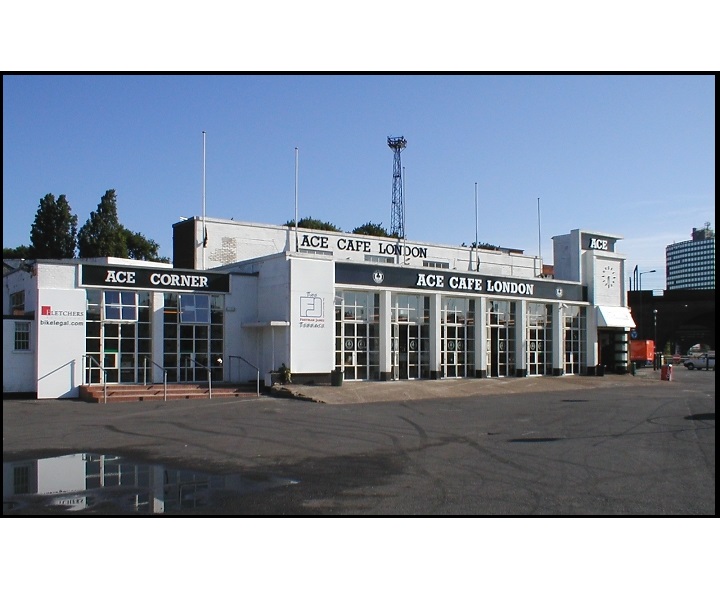
← The Ace Cafe, waiting in the morning sun for the day’s hungry visitors. Note the tell-tale tyre marks. The set-back block to the left is the former ‘restaurant’, while the rest of the building had a cafe service.
Unsurprisingly, it isn’t listed – little of the original interior survives and the building was never of any great architectural merit. Although the exterior has suffered only minor alterations beyond the window conversion, there has been no attempt to return the building to its 1949 appearance. Perhaps the original brickwork is too badly compromised to be exposed, but surely the original signage could have been replicated at moderate cost. Ah well – perhaps one day.
![]() inally … the Firestone Factory Gates, 1928
inally … the Firestone Factory Gates, 1928
We now come to these monuments to the greed of property developers in general and Trafalgar House, an unpleasant conglomerate of dubious business morals, in particular. The magnificent former Firestone tyre factory on the Great West Road was demolished at breakneck speed over the 1980 August bank holiday weekend. It was due to be listed – and thus protected from demolition – the following Tuesday, but Trafalgar House had a great deal of money riding on an unhindered redevelopment of the site. The main gates to the factory somehow survived the architectural carnage, and the Firestone factory became, in the Twentieth Century Society’s words, a martyr to its cause. Thankfully Trafalgar House was bought out in 1996 and is no more.
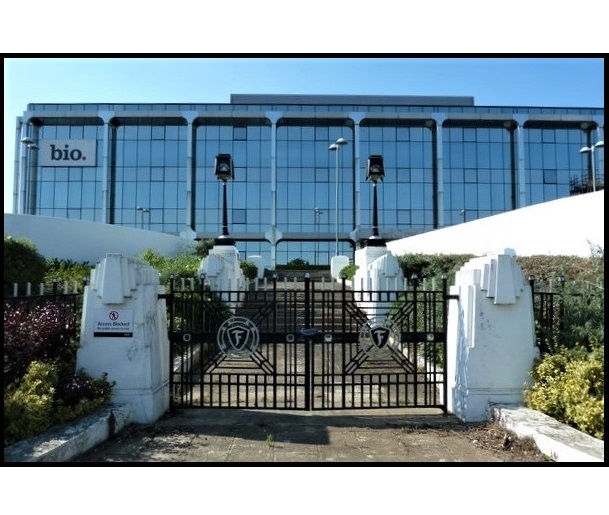
← The gates were listed Grade II in 2001. Attractive in their own right, but the abysmal third-rate edifice behind wasn’t even built symmetrically relative to the gates – the final insult.
The Museum of London has two ornate doors rescued from the factory’s entrance on display at its London Wall home.
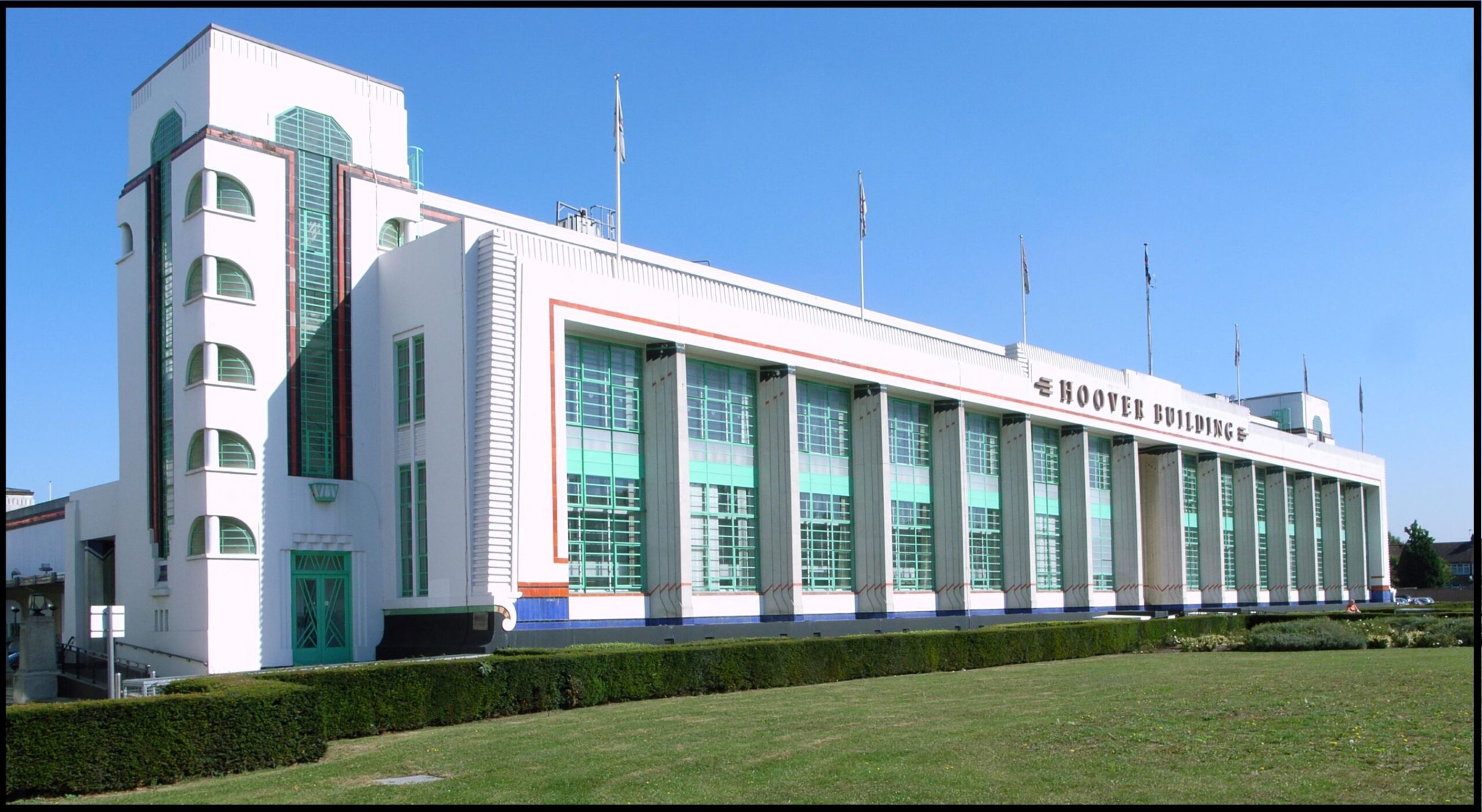
← The former Hoover factory, three miles to the North. In the same art deco style and by the same architects as the Firestone building, giving an indication of what we lost. The Hoover Building is a worthy structure in its own right, listed Grade II*. It is now divided into apartments.
P.S. I look forward to seeing what architectural gems the age of the electric car brings us. One thing’s certain: the Tesla showroom at Chiswick sure as hell ain’t one of them.
Nearest Stations:
Selected Bibliography:
Credits: